Events and Tourism: Exploring the Dynamic Relationship and Its Impacts
VerifiedAdded on 2021/04/16
|8
|1893
|55
Essay
AI Summary
This essay examines the significant role of events in the tourism industry, highlighting their evolution from the early Olympic Games to modern collaborative events like business summits and trade shows. It explores how events are repurposed for economic, social, and environmental development, detailing the positive impacts such as job creation, infrastructure improvement, and increased GDP. The essay also acknowledges the negative effects, including potential environmental damage and economic leakage. It categorizes various event types, including carnivals, sports events, and political campaigns, and analyzes their impacts on regional economies and socio-cultural aspects. The essay concludes by emphasizing the importance of sustainable development and the need for event organizers and governments to mitigate environmental issues, ensuring that events create memorable experiences while minimizing negative impacts.
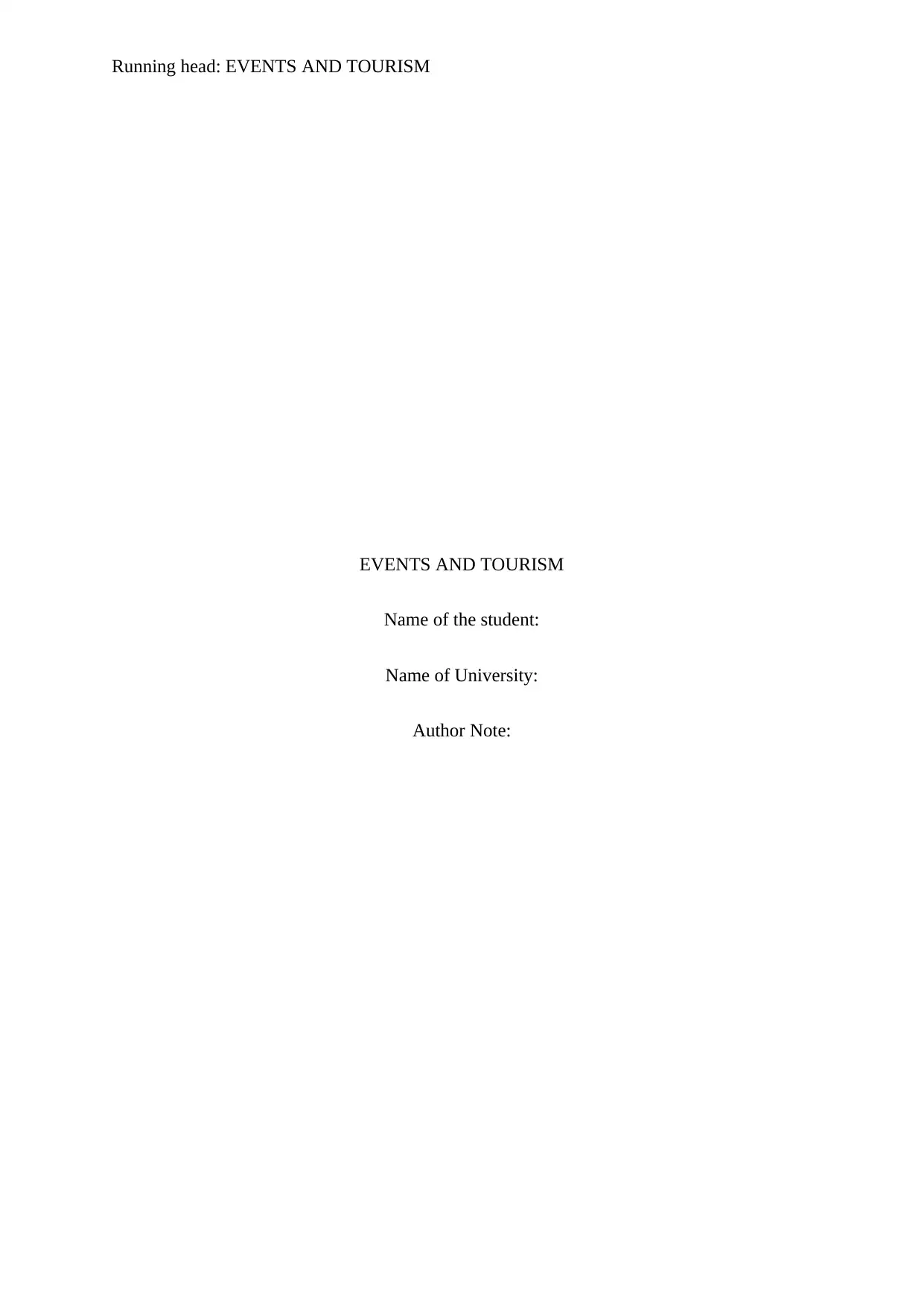
Running head: EVENTS AND TOURISM
EVENTS AND TOURISM
Name of the student:
Name of University:
Author Note:
EVENTS AND TOURISM
Name of the student:
Name of University:
Author Note:
Paraphrase This Document
Need a fresh take? Get an instant paraphrase of this document with our AI Paraphraser
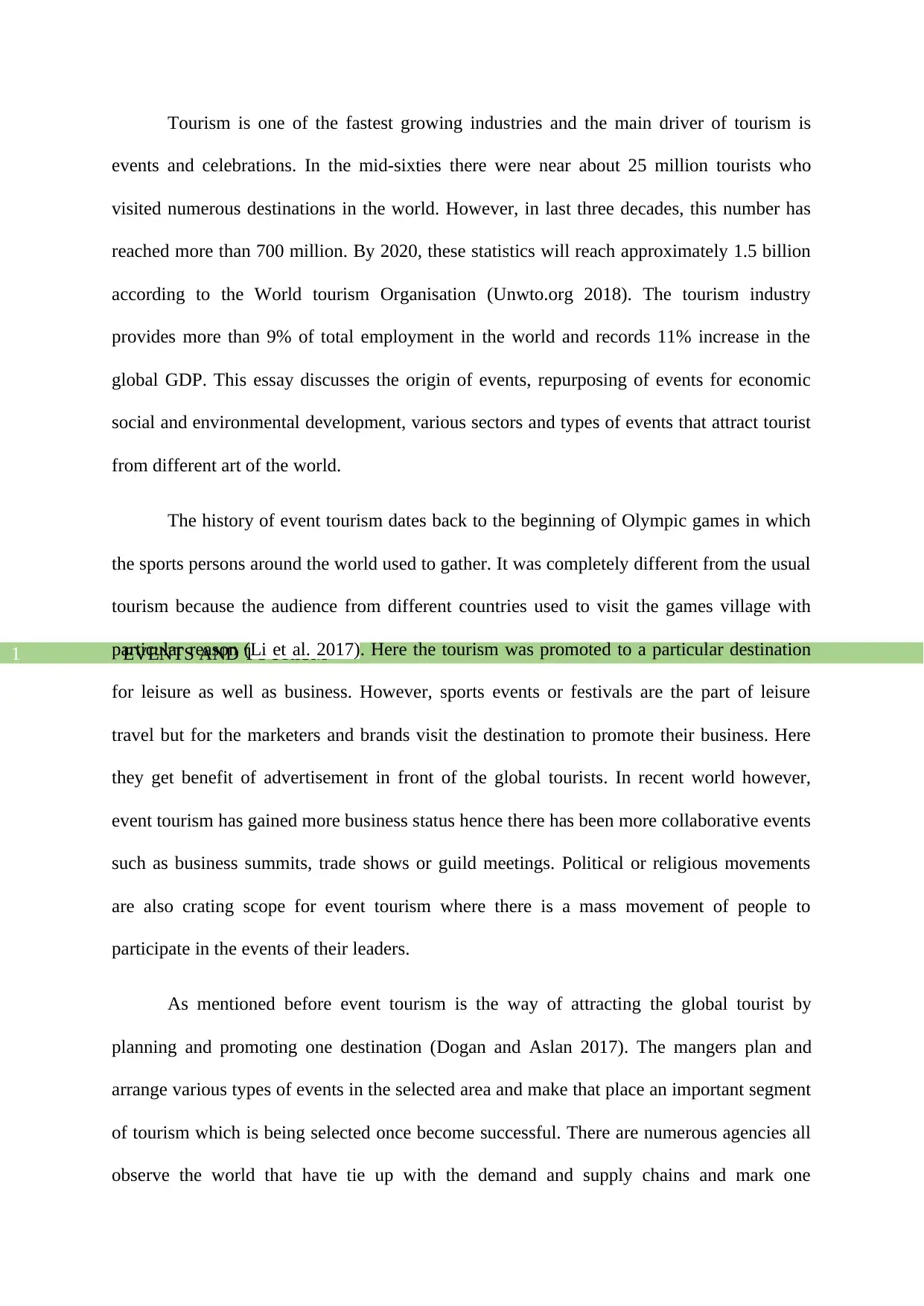
EVENTS AND TOURISM1
Tourism is one of the fastest growing industries and the main driver of tourism is
events and celebrations. In the mid-sixties there were near about 25 million tourists who
visited numerous destinations in the world. However, in last three decades, this number has
reached more than 700 million. By 2020, these statistics will reach approximately 1.5 billion
according to the World tourism Organisation (Unwto.org 2018). The tourism industry
provides more than 9% of total employment in the world and records 11% increase in the
global GDP. This essay discusses the origin of events, repurposing of events for economic
social and environmental development, various sectors and types of events that attract tourist
from different art of the world.
The history of event tourism dates back to the beginning of Olympic games in which
the sports persons around the world used to gather. It was completely different from the usual
tourism because the audience from different countries used to visit the games village with
particular reason (Li et al. 2017). Here the tourism was promoted to a particular destination
for leisure as well as business. However, sports events or festivals are the part of leisure
travel but for the marketers and brands visit the destination to promote their business. Here
they get benefit of advertisement in front of the global tourists. In recent world however,
event tourism has gained more business status hence there has been more collaborative events
such as business summits, trade shows or guild meetings. Political or religious movements
are also crating scope for event tourism where there is a mass movement of people to
participate in the events of their leaders.
As mentioned before event tourism is the way of attracting the global tourist by
planning and promoting one destination (Dogan and Aslan 2017). The mangers plan and
arrange various types of events in the selected area and make that place an important segment
of tourism which is being selected once become successful. There are numerous agencies all
observe the world that have tie up with the demand and supply chains and mark one
Tourism is one of the fastest growing industries and the main driver of tourism is
events and celebrations. In the mid-sixties there were near about 25 million tourists who
visited numerous destinations in the world. However, in last three decades, this number has
reached more than 700 million. By 2020, these statistics will reach approximately 1.5 billion
according to the World tourism Organisation (Unwto.org 2018). The tourism industry
provides more than 9% of total employment in the world and records 11% increase in the
global GDP. This essay discusses the origin of events, repurposing of events for economic
social and environmental development, various sectors and types of events that attract tourist
from different art of the world.
The history of event tourism dates back to the beginning of Olympic games in which
the sports persons around the world used to gather. It was completely different from the usual
tourism because the audience from different countries used to visit the games village with
particular reason (Li et al. 2017). Here the tourism was promoted to a particular destination
for leisure as well as business. However, sports events or festivals are the part of leisure
travel but for the marketers and brands visit the destination to promote their business. Here
they get benefit of advertisement in front of the global tourists. In recent world however,
event tourism has gained more business status hence there has been more collaborative events
such as business summits, trade shows or guild meetings. Political or religious movements
are also crating scope for event tourism where there is a mass movement of people to
participate in the events of their leaders.
As mentioned before event tourism is the way of attracting the global tourist by
planning and promoting one destination (Dogan and Aslan 2017). The mangers plan and
arrange various types of events in the selected area and make that place an important segment
of tourism which is being selected once become successful. There are numerous agencies all
observe the world that have tie up with the demand and supply chains and mark one
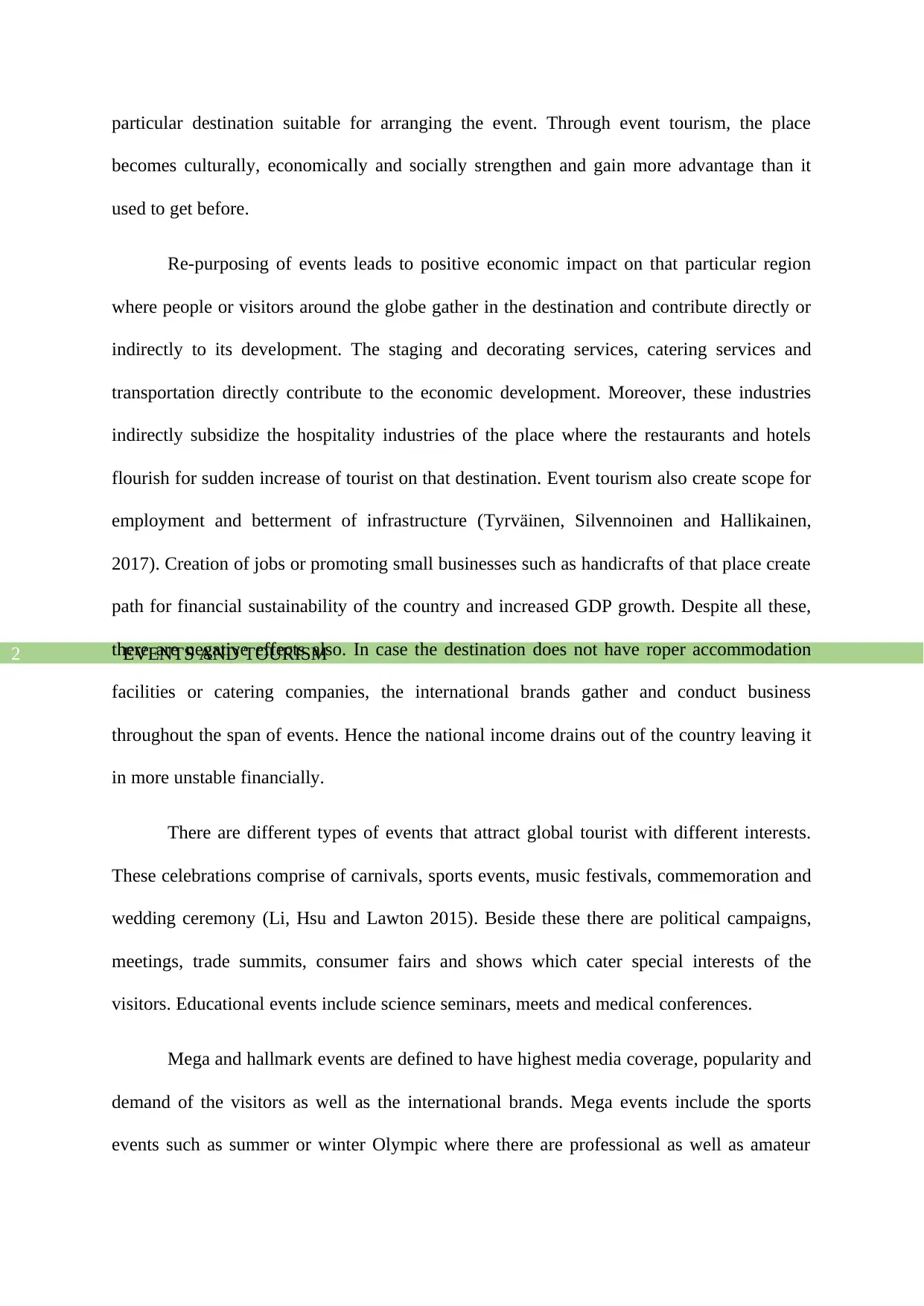
EVENTS AND TOURISM2
particular destination suitable for arranging the event. Through event tourism, the place
becomes culturally, economically and socially strengthen and gain more advantage than it
used to get before.
Re-purposing of events leads to positive economic impact on that particular region
where people or visitors around the globe gather in the destination and contribute directly or
indirectly to its development. The staging and decorating services, catering services and
transportation directly contribute to the economic development. Moreover, these industries
indirectly subsidize the hospitality industries of the place where the restaurants and hotels
flourish for sudden increase of tourist on that destination. Event tourism also create scope for
employment and betterment of infrastructure (Tyrväinen, Silvennoinen and Hallikainen,
2017). Creation of jobs or promoting small businesses such as handicrafts of that place create
path for financial sustainability of the country and increased GDP growth. Despite all these,
there are negative effects also. In case the destination does not have roper accommodation
facilities or catering companies, the international brands gather and conduct business
throughout the span of events. Hence the national income drains out of the country leaving it
in more unstable financially.
There are different types of events that attract global tourist with different interests.
These celebrations comprise of carnivals, sports events, music festivals, commemoration and
wedding ceremony (Li, Hsu and Lawton 2015). Beside these there are political campaigns,
meetings, trade summits, consumer fairs and shows which cater special interests of the
visitors. Educational events include science seminars, meets and medical conferences.
Mega and hallmark events are defined to have highest media coverage, popularity and
demand of the visitors as well as the international brands. Mega events include the sports
events such as summer or winter Olympic where there are professional as well as amateur
particular destination suitable for arranging the event. Through event tourism, the place
becomes culturally, economically and socially strengthen and gain more advantage than it
used to get before.
Re-purposing of events leads to positive economic impact on that particular region
where people or visitors around the globe gather in the destination and contribute directly or
indirectly to its development. The staging and decorating services, catering services and
transportation directly contribute to the economic development. Moreover, these industries
indirectly subsidize the hospitality industries of the place where the restaurants and hotels
flourish for sudden increase of tourist on that destination. Event tourism also create scope for
employment and betterment of infrastructure (Tyrväinen, Silvennoinen and Hallikainen,
2017). Creation of jobs or promoting small businesses such as handicrafts of that place create
path for financial sustainability of the country and increased GDP growth. Despite all these,
there are negative effects also. In case the destination does not have roper accommodation
facilities or catering companies, the international brands gather and conduct business
throughout the span of events. Hence the national income drains out of the country leaving it
in more unstable financially.
There are different types of events that attract global tourist with different interests.
These celebrations comprise of carnivals, sports events, music festivals, commemoration and
wedding ceremony (Li, Hsu and Lawton 2015). Beside these there are political campaigns,
meetings, trade summits, consumer fairs and shows which cater special interests of the
visitors. Educational events include science seminars, meets and medical conferences.
Mega and hallmark events are defined to have highest media coverage, popularity and
demand of the visitors as well as the international brands. Mega events include the sports
events such as summer or winter Olympic where there are professional as well as amateur
⊘ This is a preview!⊘
Do you want full access?
Subscribe today to unlock all pages.

Trusted by 1+ million students worldwide
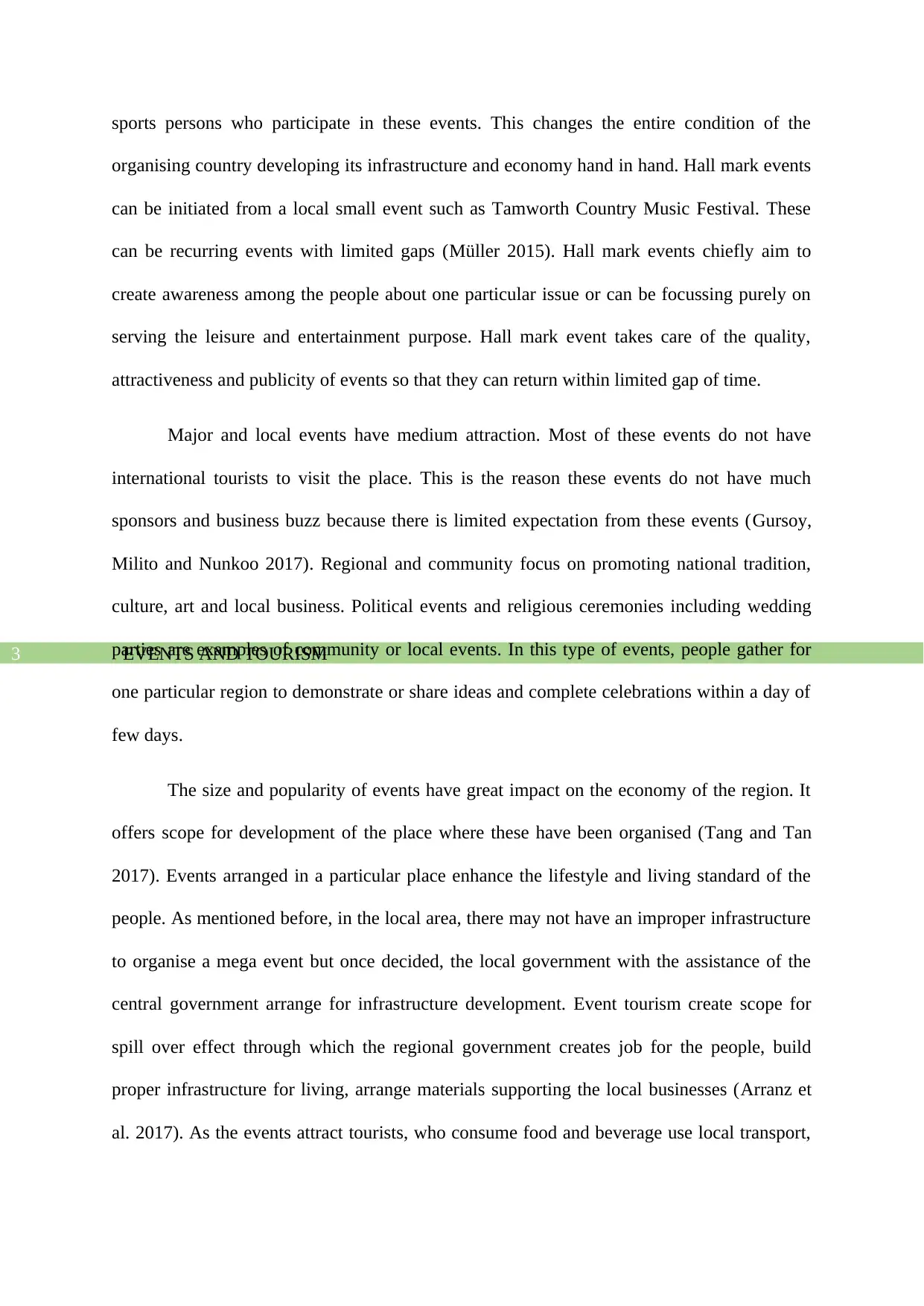
EVENTS AND TOURISM3
sports persons who participate in these events. This changes the entire condition of the
organising country developing its infrastructure and economy hand in hand. Hall mark events
can be initiated from a local small event such as Tamworth Country Music Festival. These
can be recurring events with limited gaps (Müller 2015). Hall mark events chiefly aim to
create awareness among the people about one particular issue or can be focussing purely on
serving the leisure and entertainment purpose. Hall mark event takes care of the quality,
attractiveness and publicity of events so that they can return within limited gap of time.
Major and local events have medium attraction. Most of these events do not have
international tourists to visit the place. This is the reason these events do not have much
sponsors and business buzz because there is limited expectation from these events (Gursoy,
Milito and Nunkoo 2017). Regional and community focus on promoting national tradition,
culture, art and local business. Political events and religious ceremonies including wedding
parties are examples of community or local events. In this type of events, people gather for
one particular region to demonstrate or share ideas and complete celebrations within a day of
few days.
The size and popularity of events have great impact on the economy of the region. It
offers scope for development of the place where these have been organised (Tang and Tan
2017). Events arranged in a particular place enhance the lifestyle and living standard of the
people. As mentioned before, in the local area, there may not have an improper infrastructure
to organise a mega event but once decided, the local government with the assistance of the
central government arrange for infrastructure development. Event tourism create scope for
spill over effect through which the regional government creates job for the people, build
proper infrastructure for living, arrange materials supporting the local businesses (Arranz et
al. 2017). As the events attract tourists, who consume food and beverage use local transport,
sports persons who participate in these events. This changes the entire condition of the
organising country developing its infrastructure and economy hand in hand. Hall mark events
can be initiated from a local small event such as Tamworth Country Music Festival. These
can be recurring events with limited gaps (Müller 2015). Hall mark events chiefly aim to
create awareness among the people about one particular issue or can be focussing purely on
serving the leisure and entertainment purpose. Hall mark event takes care of the quality,
attractiveness and publicity of events so that they can return within limited gap of time.
Major and local events have medium attraction. Most of these events do not have
international tourists to visit the place. This is the reason these events do not have much
sponsors and business buzz because there is limited expectation from these events (Gursoy,
Milito and Nunkoo 2017). Regional and community focus on promoting national tradition,
culture, art and local business. Political events and religious ceremonies including wedding
parties are examples of community or local events. In this type of events, people gather for
one particular region to demonstrate or share ideas and complete celebrations within a day of
few days.
The size and popularity of events have great impact on the economy of the region. It
offers scope for development of the place where these have been organised (Tang and Tan
2017). Events arranged in a particular place enhance the lifestyle and living standard of the
people. As mentioned before, in the local area, there may not have an improper infrastructure
to organise a mega event but once decided, the local government with the assistance of the
central government arrange for infrastructure development. Event tourism create scope for
spill over effect through which the regional government creates job for the people, build
proper infrastructure for living, arrange materials supporting the local businesses (Arranz et
al. 2017). As the events attract tourists, who consume food and beverage use local transport,
Paraphrase This Document
Need a fresh take? Get an instant paraphrase of this document with our AI Paraphraser
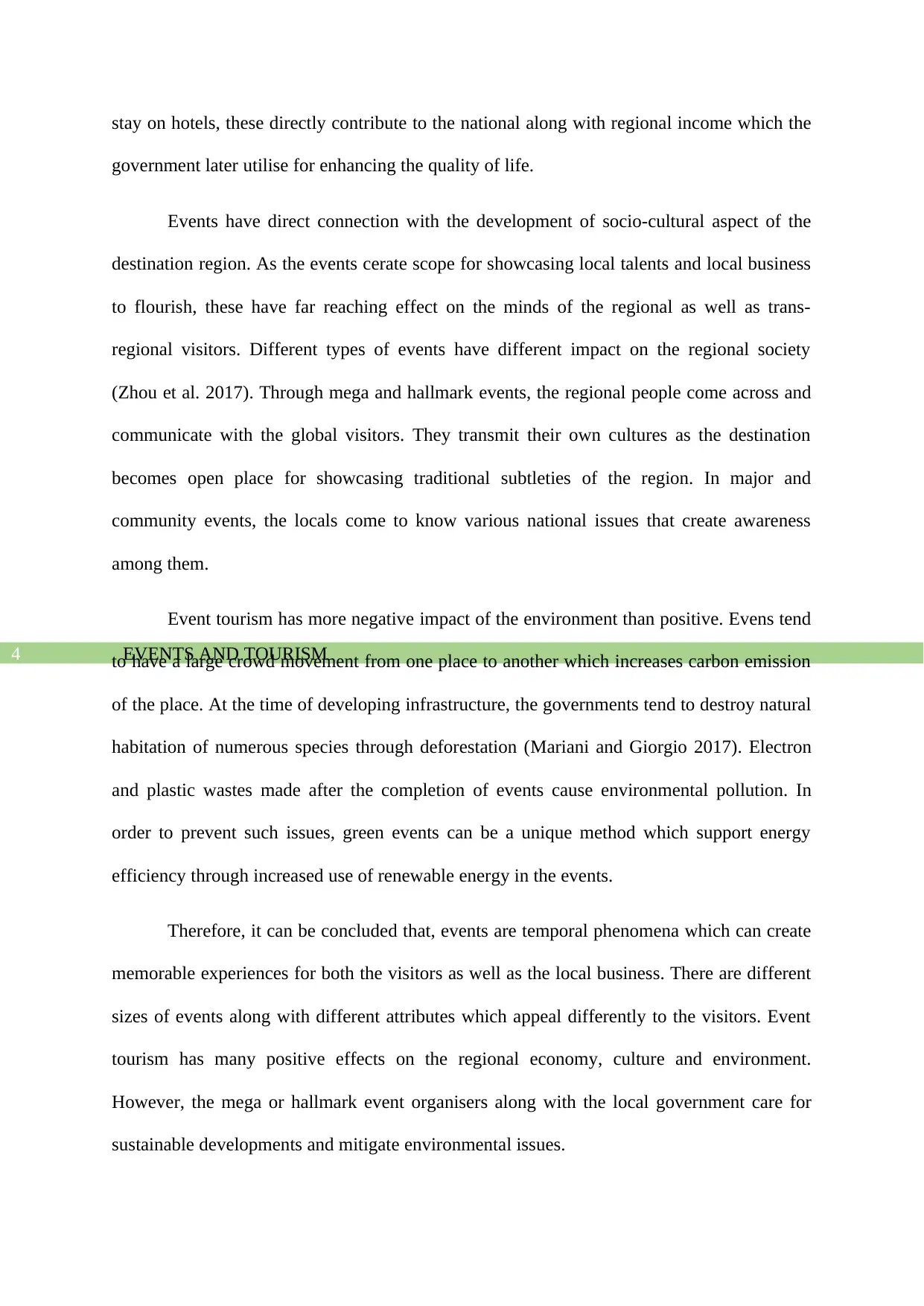
EVENTS AND TOURISM4
stay on hotels, these directly contribute to the national along with regional income which the
government later utilise for enhancing the quality of life.
Events have direct connection with the development of socio-cultural aspect of the
destination region. As the events cerate scope for showcasing local talents and local business
to flourish, these have far reaching effect on the minds of the regional as well as trans-
regional visitors. Different types of events have different impact on the regional society
(Zhou et al. 2017). Through mega and hallmark events, the regional people come across and
communicate with the global visitors. They transmit their own cultures as the destination
becomes open place for showcasing traditional subtleties of the region. In major and
community events, the locals come to know various national issues that create awareness
among them.
Event tourism has more negative impact of the environment than positive. Evens tend
to have a large crowd movement from one place to another which increases carbon emission
of the place. At the time of developing infrastructure, the governments tend to destroy natural
habitation of numerous species through deforestation (Mariani and Giorgio 2017). Electron
and plastic wastes made after the completion of events cause environmental pollution. In
order to prevent such issues, green events can be a unique method which support energy
efficiency through increased use of renewable energy in the events.
Therefore, it can be concluded that, events are temporal phenomena which can create
memorable experiences for both the visitors as well as the local business. There are different
sizes of events along with different attributes which appeal differently to the visitors. Event
tourism has many positive effects on the regional economy, culture and environment.
However, the mega or hallmark event organisers along with the local government care for
sustainable developments and mitigate environmental issues.
stay on hotels, these directly contribute to the national along with regional income which the
government later utilise for enhancing the quality of life.
Events have direct connection with the development of socio-cultural aspect of the
destination region. As the events cerate scope for showcasing local talents and local business
to flourish, these have far reaching effect on the minds of the regional as well as trans-
regional visitors. Different types of events have different impact on the regional society
(Zhou et al. 2017). Through mega and hallmark events, the regional people come across and
communicate with the global visitors. They transmit their own cultures as the destination
becomes open place for showcasing traditional subtleties of the region. In major and
community events, the locals come to know various national issues that create awareness
among them.
Event tourism has more negative impact of the environment than positive. Evens tend
to have a large crowd movement from one place to another which increases carbon emission
of the place. At the time of developing infrastructure, the governments tend to destroy natural
habitation of numerous species through deforestation (Mariani and Giorgio 2017). Electron
and plastic wastes made after the completion of events cause environmental pollution. In
order to prevent such issues, green events can be a unique method which support energy
efficiency through increased use of renewable energy in the events.
Therefore, it can be concluded that, events are temporal phenomena which can create
memorable experiences for both the visitors as well as the local business. There are different
sizes of events along with different attributes which appeal differently to the visitors. Event
tourism has many positive effects on the regional economy, culture and environment.
However, the mega or hallmark event organisers along with the local government care for
sustainable developments and mitigate environmental issues.

EVENTS AND TOURISM5
⊘ This is a preview!⊘
Do you want full access?
Subscribe today to unlock all pages.

Trusted by 1+ million students worldwide
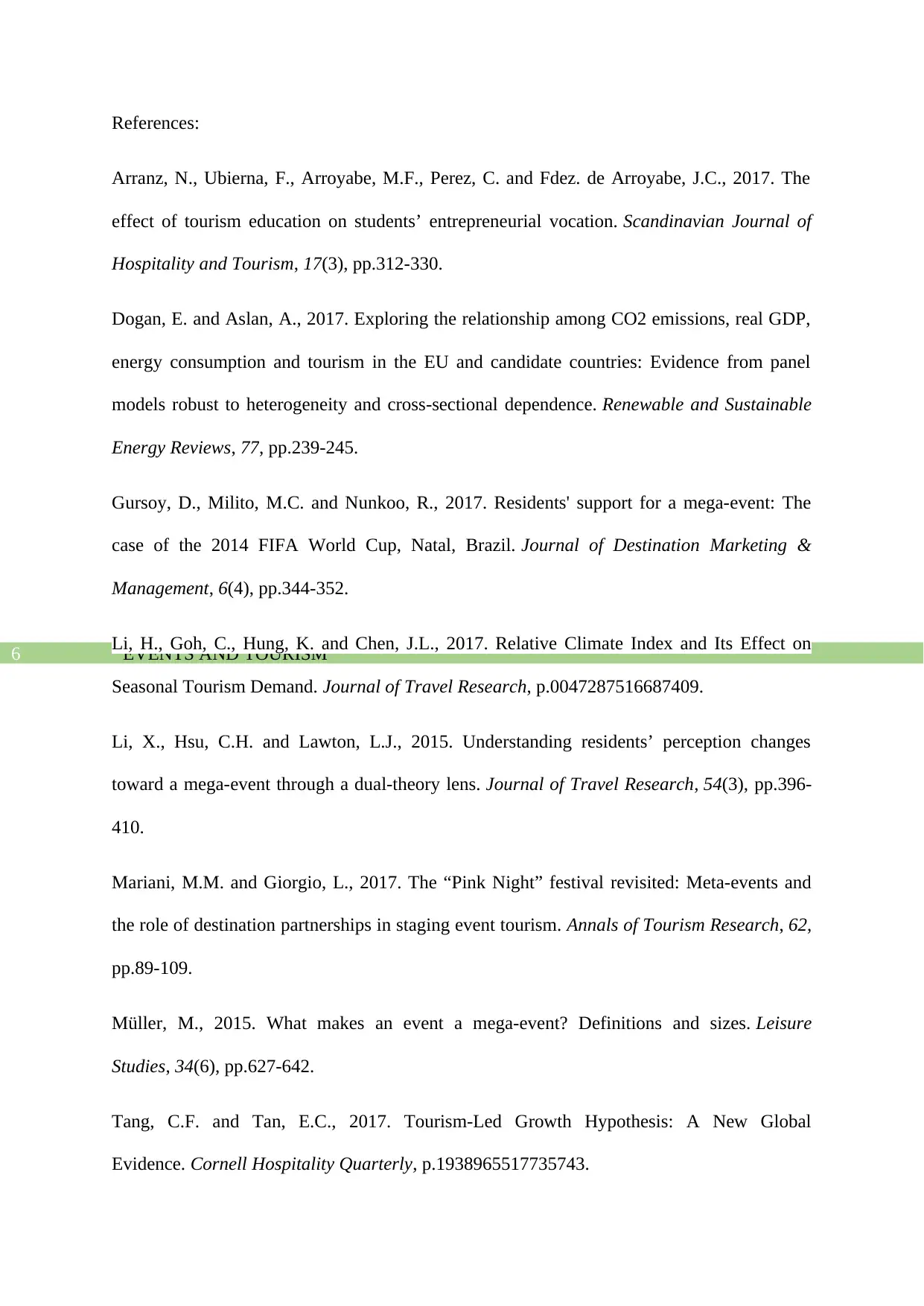
EVENTS AND TOURISM6
References:
Arranz, N., Ubierna, F., Arroyabe, M.F., Perez, C. and Fdez. de Arroyabe, J.C., 2017. The
effect of tourism education on students’ entrepreneurial vocation. Scandinavian Journal of
Hospitality and Tourism, 17(3), pp.312-330.
Dogan, E. and Aslan, A., 2017. Exploring the relationship among CO2 emissions, real GDP,
energy consumption and tourism in the EU and candidate countries: Evidence from panel
models robust to heterogeneity and cross-sectional dependence. Renewable and Sustainable
Energy Reviews, 77, pp.239-245.
Gursoy, D., Milito, M.C. and Nunkoo, R., 2017. Residents' support for a mega-event: The
case of the 2014 FIFA World Cup, Natal, Brazil. Journal of Destination Marketing &
Management, 6(4), pp.344-352.
Li, H., Goh, C., Hung, K. and Chen, J.L., 2017. Relative Climate Index and Its Effect on
Seasonal Tourism Demand. Journal of Travel Research, p.0047287516687409.
Li, X., Hsu, C.H. and Lawton, L.J., 2015. Understanding residents’ perception changes
toward a mega-event through a dual-theory lens. Journal of Travel Research, 54(3), pp.396-
410.
Mariani, M.M. and Giorgio, L., 2017. The “Pink Night” festival revisited: Meta-events and
the role of destination partnerships in staging event tourism. Annals of Tourism Research, 62,
pp.89-109.
Müller, M., 2015. What makes an event a mega-event? Definitions and sizes. Leisure
Studies, 34(6), pp.627-642.
Tang, C.F. and Tan, E.C., 2017. Tourism-Led Growth Hypothesis: A New Global
Evidence. Cornell Hospitality Quarterly, p.1938965517735743.
References:
Arranz, N., Ubierna, F., Arroyabe, M.F., Perez, C. and Fdez. de Arroyabe, J.C., 2017. The
effect of tourism education on students’ entrepreneurial vocation. Scandinavian Journal of
Hospitality and Tourism, 17(3), pp.312-330.
Dogan, E. and Aslan, A., 2017. Exploring the relationship among CO2 emissions, real GDP,
energy consumption and tourism in the EU and candidate countries: Evidence from panel
models robust to heterogeneity and cross-sectional dependence. Renewable and Sustainable
Energy Reviews, 77, pp.239-245.
Gursoy, D., Milito, M.C. and Nunkoo, R., 2017. Residents' support for a mega-event: The
case of the 2014 FIFA World Cup, Natal, Brazil. Journal of Destination Marketing &
Management, 6(4), pp.344-352.
Li, H., Goh, C., Hung, K. and Chen, J.L., 2017. Relative Climate Index and Its Effect on
Seasonal Tourism Demand. Journal of Travel Research, p.0047287516687409.
Li, X., Hsu, C.H. and Lawton, L.J., 2015. Understanding residents’ perception changes
toward a mega-event through a dual-theory lens. Journal of Travel Research, 54(3), pp.396-
410.
Mariani, M.M. and Giorgio, L., 2017. The “Pink Night” festival revisited: Meta-events and
the role of destination partnerships in staging event tourism. Annals of Tourism Research, 62,
pp.89-109.
Müller, M., 2015. What makes an event a mega-event? Definitions and sizes. Leisure
Studies, 34(6), pp.627-642.
Tang, C.F. and Tan, E.C., 2017. Tourism-Led Growth Hypothesis: A New Global
Evidence. Cornell Hospitality Quarterly, p.1938965517735743.
Paraphrase This Document
Need a fresh take? Get an instant paraphrase of this document with our AI Paraphraser
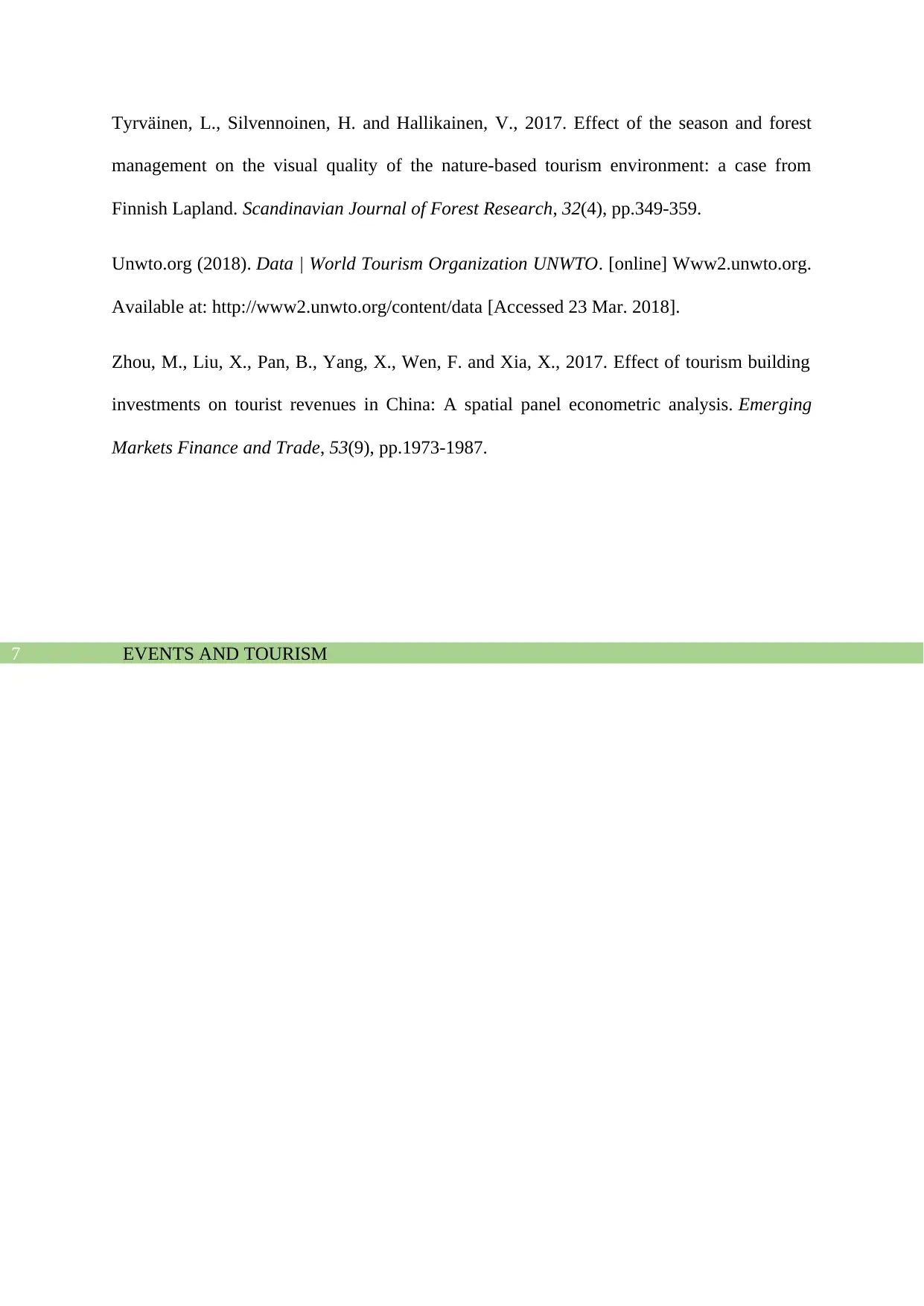
EVENTS AND TOURISM7
Tyrväinen, L., Silvennoinen, H. and Hallikainen, V., 2017. Effect of the season and forest
management on the visual quality of the nature-based tourism environment: a case from
Finnish Lapland. Scandinavian Journal of Forest Research, 32(4), pp.349-359.
Unwto.org (2018). Data | World Tourism Organization UNWTO. [online] Www2.unwto.org.
Available at: http://www2.unwto.org/content/data [Accessed 23 Mar. 2018].
Zhou, M., Liu, X., Pan, B., Yang, X., Wen, F. and Xia, X., 2017. Effect of tourism building
investments on tourist revenues in China: A spatial panel econometric analysis. Emerging
Markets Finance and Trade, 53(9), pp.1973-1987.
Tyrväinen, L., Silvennoinen, H. and Hallikainen, V., 2017. Effect of the season and forest
management on the visual quality of the nature-based tourism environment: a case from
Finnish Lapland. Scandinavian Journal of Forest Research, 32(4), pp.349-359.
Unwto.org (2018). Data | World Tourism Organization UNWTO. [online] Www2.unwto.org.
Available at: http://www2.unwto.org/content/data [Accessed 23 Mar. 2018].
Zhou, M., Liu, X., Pan, B., Yang, X., Wen, F. and Xia, X., 2017. Effect of tourism building
investments on tourist revenues in China: A spatial panel econometric analysis. Emerging
Markets Finance and Trade, 53(9), pp.1973-1987.
1 out of 8
Related Documents
Your All-in-One AI-Powered Toolkit for Academic Success.
+13062052269
info@desklib.com
Available 24*7 on WhatsApp / Email
![[object Object]](/_next/static/media/star-bottom.7253800d.svg)
Unlock your academic potential
Copyright © 2020–2025 A2Z Services. All Rights Reserved. Developed and managed by ZUCOL.




